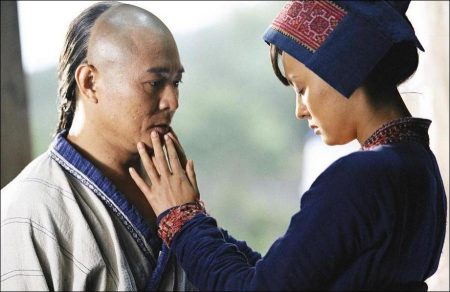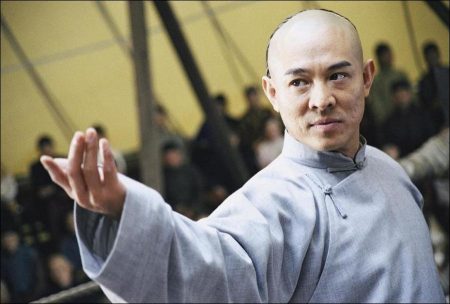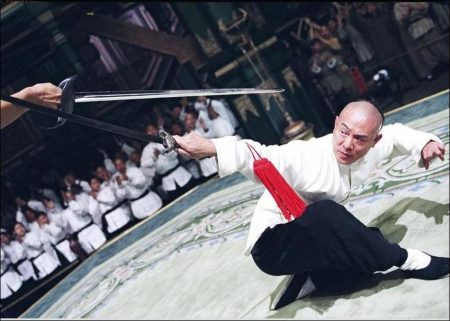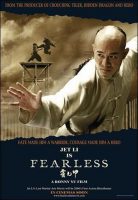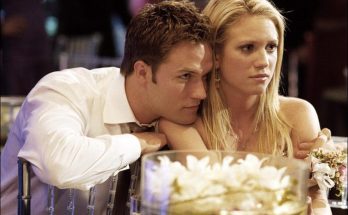Taglines: Fate made him a warrior, Courage made him a hero.
Jet Li’s Fearless movie storyline. Master Huo Yuan Jia was a supreme Martial Arts champion, founder and spiritual guru of the Jin Wu Sports Federation. “Fearless” tells his tale. Superstar Jet Li headlines this action-packed film, his final martial arts epic. The film reteams him with producer Bill Kong and action director and choreographer Yuen Wo Pin.
Li plays real-life martial arts legend Huo Yuanjia, who became the most famous fighter in all of China at the turn of the 20th Century. Huo faced incredible personal tragedy but ultimately fought his way out of darkness and into history, forever defining himself at a tournament for the honor of his country and the true spirit of martial arts.
Already a boxoffice hit in Asia, “Jet Li’s Fearless,” directed by Ronny Yu (helmer of the Hong Kong classic “The Bride with White Hair”) is Jet Li’s final martial arts masterpiece, capping a tremendous body of work in that genre. Jet Li’s Fearless reunites the actor with producer Bill Kong (“Hero”) and action choreographer Yuen Wo Ping (“Unleashed”) as he portrays real-life martial arts legend Huo Yuanjia, who became the most famous fighter in all of China at the turn of the 20th Century.
Huo faced incredible personal tragedy but ultimately fought his way out of darkness and into history, forever defining the true spirit of martial arts. His self-discovery, and the choices he made, inspired his nation. The son of a great fighter who did not wish for his child to follow in his footsteps, the bullied Huo Yuanjia resolves to teach himself how to fight – and win. Years of training enable him to ace match after match in his home region of Tianjin.
But as his fame as a martial arts master grows, so does his pride. After an ill-advised fight leads to another master’s death, members of Huo’s family are slain in revenge. Grieving and ashamed, Huo wanders the country in shock. Near death, he is rescued by women from an idyllic village, and is offered simple kindness and generosity that helps him heal and regain his equilibrium over a period of several years. Huo realizes that the future of martial arts lies in sportsmanship and not brutality, and he rejoins society to apply what he has learned.
Returning to Tianjin, Huo takes steps to come to terms with his past and restore his family’s name. His evolving, graceful Mizong (Missing) Fist method of fighting brings Huo renewed success, and he forms the progressive Jingwu Sports Federation. Taking note, duplicitous members of the Foreign Chamber of Commerce engineer a Shanghai tournament pitting Huo against four fighters, each representing the major foreign powers in China. Huo commits to the bout and faces off against, respectively, a British boxer, a Spanish swordsman, a Belgian soldier, and a Japanese martial artist. What happened that day in 1910 has never been, and will never be, forgotten in China.
A Brief History of Huo Yuanjia’s Life and Times
For centuries, China was a leading civilization, easily outpacing the rest of the world in the arts and sciences. But times and circumstances changed, and by the time Huo Yuanjia journeyed to Shanghai in 1910, China had become wracked by civil unrest. The citizens’ spirits were worn down by a lengthy period of military defeats and foreign occupation.
70 years prior, the first Opium War began and, for the first time in its history, China found itself militarily and strategically outclassed by foreigners. As a result of the Treaty of Nanjing, the country was forced to open up its ports to European traders and settlers and the opium trade started to flourish. This beginning of the era which Chinese historians refer to as “the time of unequal treaties” marked a time of unprecedented degradation for China and its people. Japan’s victory during the Sino-Japanese War further sapped the national morale in “the Weak Man of the East.”
It was in this humbling context that Huo, in 1909, founded a martial arts school, the Jingwu Sports Federation (the motto of which is “Body, Mind and Soul”). Jingwu introduced gymnastics training into its curriculum, and other schools followed suit. The school also encouraged cooperation, self-improvement, and national pride.
Huo had been born circa 1868 into a Wushu (the general Chinese-language term for martial arts) master’s family, in Dongguang County (south of Tianjin). His father made a living working as a bodyguard for wealthy people. As a child, Huo was weak and often ill; his father therefore decided not to teach Huo martial arts. But the boy was determined to learn and master martial arts. Daily, he would watch his father and brothers practice Wushu and then mimic their moves in secret, in a forest of date trees. Taking note of Huo’s determination, his father reconsidered and began to teach him martial arts. Huo learned the family’s own fighting style as well as the essentials of other schools of fighting.
In 1890, a visiting Wushu master engaged in trials of strength with Huo’s family members. The master, Du, defeated Huo’s brothers. But Huo, with one swift kick, knocked the man flat. Word of this victory spread through Huo’s village and the neighboring regions.
In 1901, Huo was present at a public match where a Russian fighter verbally insulted the Chinese people. Hearing this, Huo mounted the platform and reprimanded the man. Cowed by Huo’s bravery, the fighter apologized.
In the spring of 1909, a British fighter named O’Brien came to Shanghai and announced that he would take on any Chinese contenders. Huo accepted the challenge, and also let it be known that he in turn would fight any foreign fighters. O’Brien left Shanghai before Huo could fight him. This rout greatly enhanced the Chinese people’s morale, and Huo was spurred to found Jingwu to advance healthy body and spirit for a healthier nation. He taught as the main coach at the school.
Huo’s life was cut short on September 14th, 1910, during the Shanghai tournament that would secure his place in Chinese history. Differing theories as to the specifics of his untimely death abound. The two most prevalent ones are that he was poisoned at a peace-making banquet given by the Japanese Judo wrestlers; or that he was poisoned with jaundice medication prescribed by a Japanese doctor who was also a teacher of the tournament’s Judo competitors, and who fled Shanghai upon news of Huo’s death.
The man was gone, but his legacy was already taking hold; in shoring up China’s strength and spirit, Huo had inspired and unified an entire nation. Long revered in China as a hero and patriot, Huo’s discoveries and teachings continue to transform lives (as the Jingwu Sports Federation has branches in over 50 countries) and convey the soul of martial arts.
Director’s Statement
The road to this movie began in 2004, and by chance. I was passing through Hong Kong and, over coffee one afternoon, producer Bill Kong asked me which Chinese actor I would most like to work with. At that time, I had no plans of making a Chinese film again, since I’ve been working in Hollywood for so long. Yet, I knew immediately who I wanted to work with — Jet Li!
Jet is the only actor I know who can truly do it all; he has an authentic martial arts background, he performs all of his own stunts, and, above all, he can really act. So I told Bill that if I were to make a Chinese film again after all these years, I would only do it with Jet Li. As soon as he heard this, Bill showed me a script that he had been developing with Jet about Chinese martial arts champion Huo Yuanjia. At first, I couldn’t see a reason for making this film. Yes, there would be lots of great fight scenes; yes, Huo is a fascinating historical character; but the story still needed something that spoke to contemporary audiences…it needed a soul.
That inspiration came when I met Jet Li. He told me that each year in China, more than 280,000 people commit suicide. This weighs heavily on him, and he told me how he felt that young people today have forgotten how to believe in themselves. I was deeply affected by what he said, and all of a sudden I began to see potential in Huo’s story. Huo is a patriotic icon in Chinese history because he united all of the different schools of martial arts under one roof, and introduced China to the virtue of sportsmanship. He gave hope to his people at a time when China’s national morale was at an all-time low.
I realized that, with the troubling number of disaffected youth in China today, and with the run-up to the Beijing Olympics in 2008, now was a good time to examine what this man practiced. But I was also adamant that Jet Li’s Fearless should speak to everybody, and so the story should not be about Huo Yuanjia the hero, but rather Huo Yuanjia the man. Here was an ordinary fighter, one whose pride and arrogance nearly destroyed him, and also one who found redemption when he learned that martial arts is a spiritual challenge and not a physical one.
The Chinese character for “martial arts” is made up of two parts — characters meaning “stop” and “war.” Martial arts is a discipline that promotes peace, not violence, and that became the very heart of our story.
Hopefully, young people will come out of our film feeling empowered. — Ronny Yu
A Brief History of Wushu (the general Chinese-language term for martial arts)
A literal English-language translation of the Chinese word Wushu finds that “Wu” is “military” and “shu” is “art.” Wushu therefore means martial arts, or the art of fighting.
The Chinese-language characters for “Wushu” are Zhi (meaning “do not do” or “stop”) and Ge (meaning “fight” or “war”). Together, the characters translate into “Do not fight.” Wushu therefore also reveals the true meaning of martial arts, or the art of not fighting.
Since the Zhou Dynasty ended in 771 B.C., practical Wushu basics have included strength training, fencing, staff sparring, and spear training. There are also specific forms grouped by style, implement, and participant(s).
Wushu training has been central to China’s history. During the potent Tang Dynasty (618-907 A.D.), warriors were chosen through martial arts competitions and officers were promoted that way as well. Open communication with neighboring countries led to a global presence for Wushu in adapted forms, such as Tang Soo Do (“the Way of the Chinese Hand”). During the Ming Dynasty (1368-1644 A.D.), various forms of Wushu had taken hold in Korea, Japan, Tibet, and other countries. Karate is a variation on Southern Chinese boxing/fighting, while Judo can trace its origins to Chinese wrestling and Quinna (the precursor to Jiu-jitsu). Kung Fu and Taijiquan (Tai Chi), of course, also derived from Wushu.
Whereas Wushu was once a necessary survival skill, today it is a formal branch of study in the performance arts in China. It is the most popular national sport in a country of 1.1 billion people and is practiced by young and old alike. With the shift in emphasis from combat to performance, Wuhsu today hews that much closer to Huo Yuanjia’s vision; a practitioner is likely to be motivated by the desire for health, self-defense skills, mental discipline, and recreational pursuit.
A guiding philosophy of Wushu is that every movement must exhibit sensible combat application and aestheticism. The beauty of movement is combined with scientific training methods; routines can be performed barehanded or with traditional Chinese weaponry.
Since the 1970s, Wushu in Mainland China has been modernized so that there could be universal standards for training and competition, and the athletic and aesthetic elements could both be cultivated. While Wushu remains a performance and competitive sport, more traditional Wushu (now basically known as Kung Fu) has been maintained as the standard fighting practice. Taijiquan remains a popular form, and utilizes the body’s internal energy (“chi”).
Wushu is now an established international sport. In 1990, it became an official medal event in the Asian Games. In recent years, World Championships have drawn 56 nations to participate. With the advent of the 21st Century, inclusion in the Olympic Games is the goal.
Jet Li’s Own Wushu History
Perhaps the world’s most famous Wushu practitioner, Jet Li started his training at age 8 in Beijing. Contrary to popular myth, he never trained at the Shaolin Temple — although he would later have his breakthrough success in a film of the same name.
Li specialized in these forms; Chang Quan (Long Fist), Dao (Broadsword), Gun (Staff), Fanzi Quan (Tumbling Fist), Pu Dao (Horse Chopper), and 3-section staff.
Additionally, he has also studied a number of other styles. Among them have been Shuang Dao (Double Broadswords), Qiang (Spear), Jian (Straight Sword), Zui Jian (Drunken Sword), Zui Quan (Drunken Fist), Tang Lang Quan (Mantis Fist), and Ying Zhao Quan (Eagle Claw Boxing).
At age 11, he joined the newly created Beijing Wushu team and began competing on a national level, winning his first championship title at age 12. For the next four years, he would remain the All-Around National Wushu Champion of China, taking the title a total of five times.
Li retired from professionally competing in the sport after sustaining a knee injury, and began making movies. His Wushu training has informed his film work, and been actively demonstrated on-screen. Some of his Beijing Wushu teammates have appeared in movies with him.
Other notable practitioners of Wushu include actor Ray Park (well-known as Darth Maul in the Star Wars canon) and Indonesian WBA Featherweight champion Chris John.
Behind the Scenes of the Movie
Jet Li is the world’s most accomplished martial arts star, and has honed his acting talent in addition to his skills as a fighter. He has indicated that Jet Li’s Fearless is his final martial arts epic, capping a tremendous body of work in the genre that includes such classics as Once Upon a Time in China, Fong Sai Yuk, and Fist of Legend, among others.
Li has long wanted to play Huo Yuanjia, and worked for over a decade on development of a movie about him. Producer Bill Kong, who had made the international blockbuster Hero with Li and also produced the Academy Award-winning Crouching Tiger, Hidden Dragon (each of which was set in periods of Asian history), joined forces with the actor to get the movie made at last.
The filmmakers knew that a screen version of Huo’s story had to convey more than just the expected action. Jet Li’s Fearless director Ronny Yu comments, “In the beginning, Huo thought that being number one — the champion martial artist — was what life was all about. Ours is not an ordinary action film; it is a martial arts film — and one about the futility of violence. It’s actually about making peace; the better martial artist you are, the better peacemaker you are.”
In 1997, Li had considered retirement. He remembers, “My Tibetan master said, `You can’t retire; you have some responsibilities in the future. I asked, `Can you tell me what these are?’ He said, `No one can tell you; you need to figure out yourself.'” With the completion of Jet Li’s Fearless, Li has answered his own questions.
As a script took shape from screenwriters Chris Chow and Christine To, the planned screen incarnation of the icon became imbued with many of the actor’s own experiences. Li confirms, “This character is quite close to me. I put a lot of my life experiences into Jet Li’s Fearless; I put my heart in it, all my beliefs, the physical part, the mental part — all I’ve been learning in martial arts since I was 8 years old.
“When you watch this film, you’ll really know Jet Li — my philosophy, everything, through martial arts. I express all that martial arts means in my life through this character; why I’m learning martial arts, what martial arts is to me.”
Once filming began, with the actor getting into character, the line began to blur a little further. Further, with Li coiffed and costumed to play a hero from an earlier period in Chinese history, those on the shoot were instantly reminded of his vibrant portrayals of Huang Fei Hung [/Wong Fei Hung] and Fong Shi Yu [/Fong Sai Yuk]. As Yu remarks, “This generation has seen Jet Li advance martial arts, and so he is in many ways a modern-day Huo Yuanjia.”
To which Li responds, “Well, if I am like Huo, then Ronny is like Moon [the blind girl Sun Li portrays in Jet Li’s Fearless], inspiring me to push my work to a new level and helping me see martial arts in a whole new light.”
Also helping Li finally bring Huo Yuanjia to the screen is a close personal friend and longtime colleague, action choreographer extraordinaire Yuen Wo Ping. The duo had just recently managed a reteaming on the hit Unleashed, and Li was not about to make this highly personal project without Wo Ping. The actor explains, “Working together or separately, we’ve always relied on martial arts to help the character and the story. But who knows when we will have the chance to work together again? So, for this movie, we approached it as though it would be the last time we would be making a film together. People ask, `How do you make fights different?’ Well, humans only have two arms and two legs, so it’s very hard to come up with something totally new. What we could do this time was to have a great story in which to utilize the action.”
Wo Ping adds, “On this film, there are no parlor tricks. We lay it all bare for the audience, so you can tell that the fight you are watching is the real thing.”
Director of photography Poon Hang Sang remarks, “Jet’s actions often can’t be captured at normal film speeds.” Accordingly, some sequences were filmed at six times normal speed, so that movements could be captured on camera and edited into the movie in slow motion.
Jet Li’s Fearless marks the first time — out of nearly three dozen films in nearly thirty years — in which Jet Li will fight predominantly in an arena. “This presented a challenge for choreographing the action,” admits Wo Ping. “We can’t vary the audience’s experience with different sets and locations, so this forced us to be more imaginative with the action and the movement.”
In line with the story’s climactic match, the filmmakers convened an impressive international cast of world-class fighters. The roster grew to include seven-time World Kickboxing champion Jean Claude Leuyer (in the tournament sequence, as the English boxer); World Wrestling All-Stars hero and Australian bodybuilding champion Nathan Jones (in the wrestling-ring sequence); and acknowledged sword-fighting master Anthony De Longis (as the Spanish swordsman, in the tournament sequence). For Wo Ping, this made his work both easier and more difficult. He explains, “Working with people who knew how to fight meant that we could push the action harder, and experiment more. There are things that these guys can do that ordinary actors could never do, and as I pushed them to the next level, so too did they demand more of me.”
The unprecedented caliber of fighting talent on Jet Li’s Fearless also meant that Ronny Yu could call “action” and get precisely that — and in enviably long takes that showcase the fighters’ skill, since there were no novices to work around by way of fast cuts and close-ups.
Further, by introducing fighters to the world of Chinese Wushu, the action sequences were infused with fresh possibilities. Li enthuses, “We could really unleash our imaginations — like, how would a Chinese broad sword hit a Prussian blade? And how would a Chinese martial artist fight an American wrestler twice his size? The fighting sequences in this movie were exhaustive — and exhilarating.”
Out of a 90-day shooting schedule, 60 were spent filming action sequences. Yu adds, “This is the most difficult picture I’ve ever made. I didn’t want to confine Jet; I wanted to give him room to play. With so much room, magic comes up; Jet would bring in his own ideas, which would make sequences better.
“Wo Ping understands how to protect Jet — and make him look good. Because they’ve been working together for so many years, they don’t have to second-guess each other.” Li adds, “We examined every style of Wushu there is — different styles, different weapons, different fighters — and the result is a film for true martial artists.”
Popular Chinese actor Dong Yong was brought on to play Huo’s stalwart childhood friend-turned-sponsor, Nong Jinsun. Acclaimed Japanese actor Nakamura Shidou (Be With You) learned to speak Chinese for his role as Japanese challenger Anno Tanaka. Yu admits, “It would have been easier to dub Nakamura’s lines, but he wanted to speak the words himself, to get into character. I have huge respect for his talent and integrity.”
Striving for historical accuracy in addition to the martial arts accuracy, the crew built elaborate sets to capture the beauty and turbulence of turn-of-the-century China. Yu and several crew members traveled hundreds of miles throughout China to find the location that would be the ideal village setting for the sequences of Huo’s redemption. The director notes, “When we came across this abandoned village in the remote Zhejiang Province, I knew it was the perfect spot. But it wasn’t easy to film there, so we literally had to build a road so that we could access the village. It was worth it!”
For the pivotal role of Moon in the village sequences, Yu met with hundreds of actresses, but none of them had the inherent quality of serenity that was so essential to the part. But once Yu “saw a photo of Sun Li, I knew immediately that we had found our Moon.”
While Moon was not the first role for Sun Li — who is already a television star in China — the young actress was a screen newcomer. Accordingly, she undertook extensive research and preparation to play the blind young woman who helps give Huo’s life new purpose; the actress volunteered at a school for blind children in her native Shanghai.
Sun Li says, “The love that Moon shares with Huo comes from the heart. But, like Wushu itself, their love is about the spiritual experience rather than the physical one.”
Yu comments, “All the emotional and dramatic scenes that Jet plays in Jet Li’s Fearless touched me, and I hope will touch audiences too.”
For Jet Li, martial arts have long been about more than fighting and violence. He notes, “This movie’s philosophy is, you can use martial arts to help people, not just for violence. That’s another of my personal beliefs; violence is not the only solution. Wushu is not `I fight you, you fight me’; it’s to stop that. You can beat up someone’s body, but that doesn’t change their heart.”
By telling the story of a trailblazing martial artist, Jet Li’s Fearless affords the actor a valedictory on the subject as he moves into new phases of his storied career. “It’s not enough to know how to fight,” he states. “You have to understand the spirit of martial arts. It’s also not enough to have a strong body; you have to have a strong soul. Huo had both.”
Jet Li’s Fearless (2006)
Directed by: Ronny Yu
Starring: Jet Li, Betty Sun, Dong Yong, Nakamura Shidou, Sun Li, Ailing Xu, Hee Ching Paw, Nathan Jones, Shidô Nakamura, Jean Claude Leuyer, Zhi-Hui Chen, Jacky Heung, Collin Chou
Screenplay by: Chris Chow, Christine To
Production Design by: Kenneth Mak
Cinematography by: Hang-Sang Poon
Film Editing by: Virginia Katz, Richard Learoyd
Costume Design by: Thomas Chong
Art Direction by: Zhanjia Yang
Music by: Shigeru Umebayashi
MPAA Rating: PG-13 for violence and martial arts action throughout.
Distributed by: Focus Features
Release Date: September 22, 2006
Views: 145
